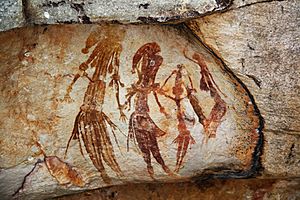Indigenous Australian art facts for kids
Indigenous Australian art is made by Aboriginal Australian and Torres Strait Islander peoples. This art includes many different styles and materials. You can find paintings on leaves and bark, wood carvings, rock carvings, and even sand painting. This art has been made for thousands of years, from ancient times to today.
Contents
Traditional Indigenous Art Forms
Indigenous Australian art is the oldest continuous art tradition in the world. It includes many styles like rock painting, dot painting, bark painting, carvings, and weaving.
Stone Art: Paintings and Engravings

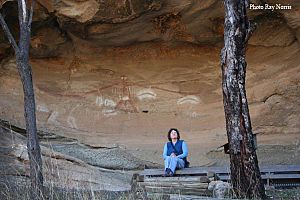
Rock art includes paintings and carvings (petroglyphs). You can find these artworks all over Australia. Some rock art shows animals that are now extinct, like the Genyornis (a giant bird) and Thylacoleo (an ancient lion). Other art shows more recent events, like the arrival of European ships.
The oldest rock art in Australia is about 40,000 years old. It is found in Western Australia's Pilbara region and South Australia's Olary area. A charcoal drawing found in the Narwala Gabarnmang rock shelter in the Northern Territory is 28,000 years old. This makes it one of the oldest dated rock art pieces on Earth.
A large painting of a macropod (like a kangaroo) in Western Australia's Kimberley region is about 17,300 years old.
The Gwion Gwion rock art (also called "Bradshaw rock paintings") are found in caves in the Kimberley region of Western Australia. Studies suggest this art is about 12,000 years old.
The Maliwawa Figures are another important discovery. These are 572 images found across 87 sites in northwest Arnhem Land. They are thought to be between 6,000 and 9,400 years old. These paintings are special because they show bilbies and dugongs, which are not usually seen in Arnhem Land art. They also show relationships between people and animals, which is rare.
Other famous rock art sites include Laura, Queensland, Ubirr in Kakadu National Park, Uluru, and Carnarvon Gorge.
Rock engravings are made by carving into rock. Famous sites include Murujuga in Western Australia, the Sydney rock engravings in New South Wales, and the Panaramitee rock art in Central Australia. The Toowoomba engravings are unique, showing carved animals and humans in a style not found elsewhere.
The engravings at Murujuga are the world's largest collection of rock carvings. They show extinct animals like the thylacine (Tasmanian tiger).
Stone Arrangements
Aboriginal stone arrangements are artworks made by carefully placing stones in patterns. Each stone is usually about 30 cm big and set into the ground. Some arrangements are very large, covering many metres.
A great example is at Wurdi Youang in Victoria. It has about 100 stones in an egg shape, about 50 metres wide. It looks a bit like the ancient stone circles in Britain. Its exact purpose is not fully clear, but it might have been used for special ceremonies or for watching the stars.
Smaller stone arrangements are found across Australia. For instance, near Yirrkala, there are arrangements that show praus (boats) used by Macassan fishermen.
Wood Carvings
Wood carving has always been a key part of Aboriginal culture. Artists used wood, sharp stones, and fire to create their carvings. They would heat wire with fire to make patterns on the wood.
Aboriginal people made wood carvings to share their Dreaming stories. These stories teach about their land, customs, and history. Carvings were also used in ceremonies.
The Tiwi Islands people traditionally carved pukumani grave posts. Since the 1960s, they have also carved and painted ironwood figures.
Textiles and Weaving
In many Pacific cultures, women often create art from felted cloth made from tree bark and plants. This includes detailed clothing worn for rituals. These clothes showed a person's wealth and importance in the group. They were also used in trade and to build friendships between groups.
Basket weaving has been a traditional practice for Aboriginal women for centuries. Baskets were made by twisting bark, palm leaves, and feathers. Some were plain, while others had feathers woven into them. Artists used natural dyes from minerals and plants to colour the materials. These bags and baskets were used for religious ceremonies and for carrying items.
Jewellery
Aboriginal people made valuable shell pendants. These shells were often used for trading. They were attached to strings made from human hair, sometimes covered with grease and red ochre. Men would wear this jewellery around their necks or waists for ceremonies.
Kalti Paarti: Emu Egg Carvings
Kalti paarti carving is a special art form where artists carve designs into emu eggs. This technique is newer than other traditional arts, starting in the 1800s.
Symbols in Aboriginal Art
In modern Aboriginal art, some symbols have the same meaning across different regions. However, the meaning of symbols can change depending on the painting's context. For example, circles within circles can mean a campfire, a tree, a hill, a digging hole, or a waterhole. The artist's group and the use of colour can help clarify the meaning. For instance, water might be shown in blue or black.
Many Aboriginal paintings, especially those telling a Dreaming story, are shown from an aerial (bird's-eye) view. The story often follows the landscape, as created by ancient spirits. Modern paintings are a new way to share old songs, ceremonies, and rock art traditions that are thousands of years old.
To understand the symbols, you need to look at the whole painting, where the artist is from, the story behind the art, and the painting's style.
Religious and Cultural Meaning
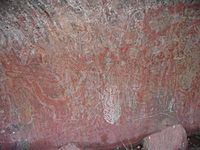

Some natural places were sacred to Indigenous Australians. These places were used for seasonal rituals where people created art like feather objects, rock engravings, and bark paintings.
The Dreaming (or Jukurrpa) is a shared belief among all Aboriginal peoples. It tells how ancient ancestor spirits created the land and sky. These beliefs are the foundation of their laws, art, and ceremonies. Traditional Aboriginal art almost always has a link to the Dreaming.
Wenten Rubuntja, an Indigenous artist, said that almost all Aboriginal art has spiritual meaning. He explained that painting is a form of worship, work, and culture, all connected to the Dreaming.
Storytelling and showing totems (special animals or objects linked to a family or group) are very important in Aboriginal art. In some famous sites in Arnhem Land, art often shows the female form, especially the womb, in an "X-ray" style. This style, dating back to 2000–1000 BCE, shows the inside of living things. The mimi spirits, who taught painting to Aboriginal people, are "released" through these artworks.
Protecting Art Sites
Many important Aboriginal rock art sites have been damaged over time by early settlers and modern visitors. This includes damage from clearing land, construction, and graffiti. Some sites are now strictly watched by rangers or closed to the public to protect them.
Torres Strait Islander Art
Torres Strait Islander art is deeply connected to the ocean and island life. It often features animals like turtles, fish, dugongs, sharks, and saltwater crocodiles, which are important totems.
Elaborate headdresses called dhari are made for ceremonial dances. The dhari is a powerful symbol of the Torres Strait Islander people, representing peace and harmony today. Famous artist Ken Thaiday Snr creates amazing dharis using modern materials.
Torres Strait Islander people are the only culture in the world to make turtleshell masks. These are called krar or le-op.
Another important art form is wame (or wameya), which are different string figures.
The Islands have a long history of woodcarving, used for masks, drums, and other ceremonial items. In the 1970s, young artists started learning art as traditional myths and legends were being rediscovered. Books by Margaret Lawrie helped bring forgotten stories back to life, inspiring these artists.
In the 1990s, younger artists like Dennis Nona started making prints (like linocuts and etchings) and larger bronze sculptures. Other great artists include Billy Missi and Alick Tipoti. These artists have brought new styles and stories to Australian Indigenous art, combining Melanesian carving skills with their unique culture.
Contemporary Indigenous Art
Modern Aboriginal Artists
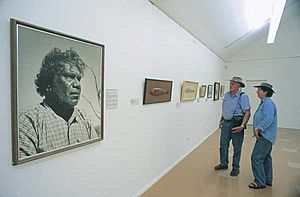
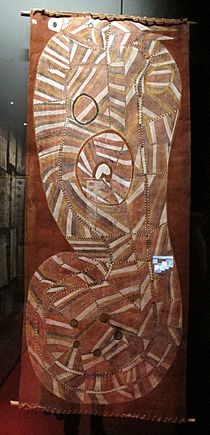
In 1934, Australian painter Rex Batterbee taught Aboriginal artist Albert Namatjira how to paint landscapes using watercolour. This happened at the Hermannsburg mission in the Northern Territory. This style became very popular, known as the Hermannsburg School. Namatjira became famous and was the first Aboriginal Australian citizen because of his art.
In 1966, one of David Malangi's designs was used on the Australian one-dollar note without his knowledge. He was later paid for it, which was the first time Aboriginal copyright was recognized in Australia.
In 1988, the Aboriginal Memorial was put on display at the National Gallery of Australia in Canberra. It has 200 hollow log coffins, like those used in ceremonies in Arnhem Land. It was made to remember Aboriginal people who died protecting their land during European settlement.
That same year, the new Parliament House in Canberra opened with a mosaic design by Michael Nelson Tjakamarra in its forecourt.
Rover Thomas was another well-known modern Aboriginal artist. He represented Australia at a big art show in Venice in 1990. He encouraged other artists like Queenie McKenzie and Paddy Bedford to paint.
In the late 1980s, the art of Emily Kngwarreye became very popular. She had done craftwork for most of her life, but only became known as a painter in her 80s. Her styles changed every year, mixing traditional Aboriginal and modern Australian art. Many other Indigenous artists from central, northern, and western Australia have also become very popular, including her niece Kathleen Petyarre and artists like Angelina Pwerle and Dorothy Napangardi.
The art market for Indigenous art is now worth a lot of money each year.
Papunya Tula and "Dot Painting"
In the early 1970s, art teacher Geoffrey Bardon encouraged Aboriginal people in Papunya to paint their Dreaming stories on canvas. These stories were usually drawn in the desert sand, but now they could be kept permanently.
The "dots" in these paintings were sometimes used to cover secret parts of sacred ceremonies. The artists formed their own company, Papunya Tula Artists Pty Ltd. However, some artists were criticized for showing too much of their sacred heritage to the public. Much of the Aboriginal art you see in tourist shops today comes from this "dot painting" style.
One of the most famous artists from this movement was Clifford Possum Tjapaltjarri. Another was Johnny Warangkula, whose painting Water Dreaming at Kalipinya sold for a record price.
The Papunya Collection at the National Museum of Australia has over 200 artworks, including early dot paintings.
Challenges in the Art Market

Sometimes, people have taken advantage of Aboriginal artists, especially those who don't speak English or are not used to business. This has led to concerns about unfair practices.
For example, some artists were offered cars in exchange for many paintings. These cars often had problems. Sick artists were also sometimes targeted by dealers looking to make quick money. Even famous artists like Emily Kngwarreye faced pressure to produce many paintings.
In 2006, there were reports of art fraud in Western Australia. Some people claimed that backpackers were painting "Aboriginal art" that was then sold to tourists. The Australian Senate investigated these issues and suggested new rules to protect artists and their art.
Art Movements and Cooperatives
Many contemporary Indigenous artworks are created in community groups and art centres. Unlike many Western artists who work alone, Indigenous artists often work together.
Many of these centres have online art galleries where people can buy art directly from the communities. This helps artists get a fair price for their work. These cooperatives show the wide variety of art styles across Indigenous Australia, from ochre paintings in the northwest to cross-hatching in the tropical north, and dot paintings from the central desert. Art is becoming a very important way for these communities to earn a living.
Awards for Indigenous Art
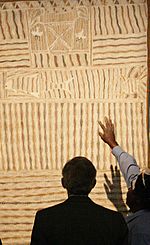
Indigenous Australian art is recognized with many awards. For example, the West Australian Indigenous Arts Awards celebrate talented artists. In 2013, Churchill Cann won the Best West Australian Piece, and Brian Robinson won the Best Overall prize.
Protecting Traditional Cultural Expressions
"Traditional cultural expressions" refers to artistic and literary forms that show traditional culture and knowledge. This includes handmade textiles, paintings, stories, ceremonies, music, and dance. These expressions are passed down through generations.
Some Indigenous communities prefer not to use the word "traditional" because it can make it sound like their culture is stuck in the past. They want to show that their culture is alive and changing.
Indigenous Art in International Museums
Indigenous Australian art is becoming well-known around the world. Many museums now feature these artworks.
The Museum for Australian Aboriginal art "La grange" in Switzerland is one of the few museums in Europe dedicated entirely to this art. The Musée du Quai Branly in Paris also has a collection of Australian Aboriginal art.
Two museums that focus only on Australian Aboriginal art are the Museum of Contemporary Aboriginal Art (AAMU) in the Netherlands, and the Kluge-Ruhe Aboriginal Art Collection at the University of Virginia in the United States.
See also
 In Spanish: Arte aborigen australiano para niños
In Spanish: Arte aborigen australiano para niños
- Art of Australia
- Australian Aboriginal fibre sculpture
- Dampier Rock Art Precinct
- List of Indigenous Australian art movements and cooperatives
- List of Indigenous Australian visual artists
- List of Stone Age art
- Memorial pole
- National Aboriginal & Torres Strait Islander Art Award
- National Indigenous Heritage Art Award
- Panaramitee Style


